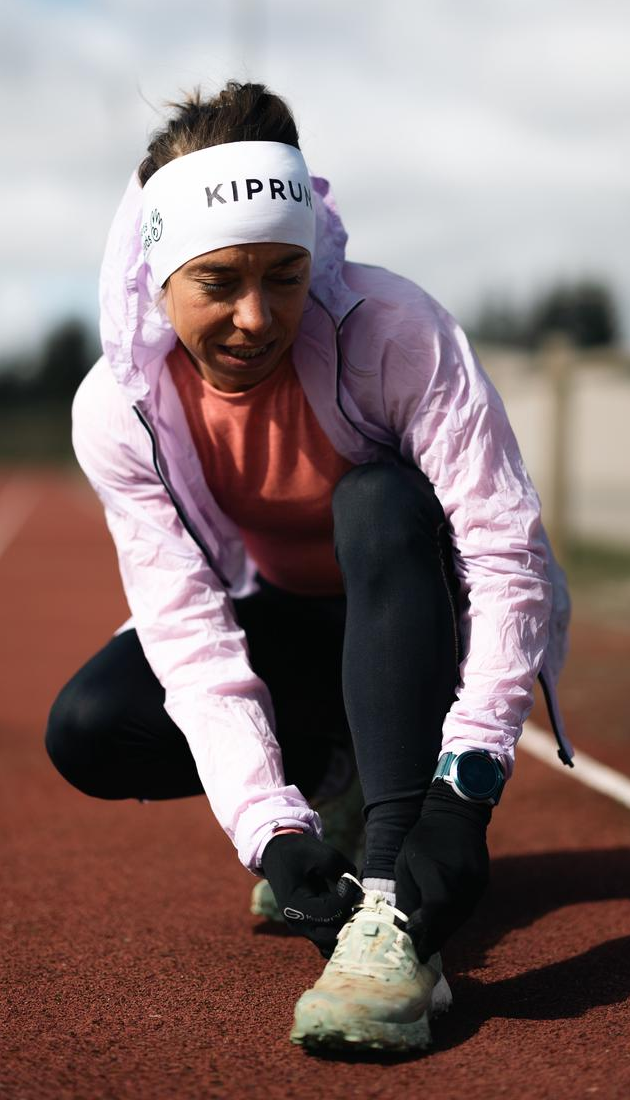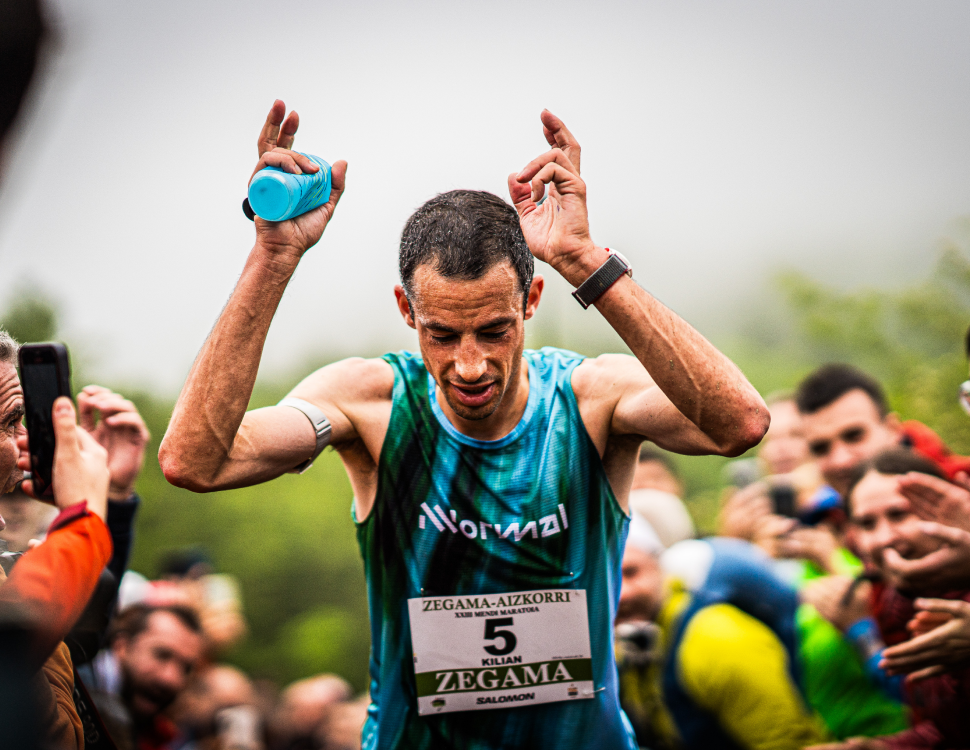In the world of running, setbacks are inevitable. However, this was not something that Blandine L'hirondel, an avid French trail runner, could have ever imagined happening after celebrating one of the biggest accomplishments of her running career. When an injury put her passion at risk, instead of giving up, Blandine tackled her comeback with grit and a smart plan.
Read more about how she used the Running Form Test as a part of her return to the trails.
Blandine's Injury
Blandine is most recently known for her 3rd-place finish at the 2023 UTMB World Series. With all of the excitement from this major accomplishment, she did not take the proper time for recovery post-race and unfortunately in October suffered a stress fracture in her left heel putting a complete stop on any training.

Base Fitness and Intensity Trend of Blandine as seen from COROS Training Hub.
COROS Education. Base Fitness refers to your ability to sustain harder workouts, while Intensity Trend refers to you the tigue that comes with training.
Blandine took three months to rest and rehab before she could gradually return to running. Immediately following the injury, she was on crutches for 3-weeks before she could introduce some easy cross-training like cycling and walking. She attempted to reintroduce running at week 8 but experienced some pain, which set her recovery back 2 weeks.
She worked with her physiotherapist throughout the entire 3-month rehab process to ensure that she was being both smart and safe with returning to the sport. After 12 weeks of rehab, Blandine was cleared to start running again by focusing on gradually increasing the time that she was running. The time went from 15 minutes to 1 hour in just two weeks!
A Well-Monitored Return to Running
The Running Form Test is a tool that can be used throughout training to help improve your performance as a runner. The test will help identify your strengths and weaknesses from a biomechanics standpoint. After the test is performed, based on the results, you can put together a strength training plan to help improve areas of weakness. After a few weeks of being consistent with the targeted exercises, you can re-test and see if there is improvement.
The Running Form Test has been an additional tool in Blandine's return to running. She completed two tests within 3 weeks apart so that she could see how the work that she was putting in with her training and physio was helping to increase her fitness.

photo credit: Simon Dugué - @simon.dugue
After running form the first time on February 6th with a blood lactate test, Blandine completed her first Running Form Test 3 days later on the track. The first test overall went well for Blandine, she felt good with her cardio but noticed getting back to running wasn't as easy.
During the first test, my legs felt a little heavy and I felt a little limited with my biomechanics. But running feels very good, there is no more pain!!
Between the two tests, Blandine resumed running workouts more consistently and included more plyometric sessions to help improve her cadence and balance. Both of these were skills that showed weaknesses during the test at the beginning of February.
Her second test showed that the time she took to focus on improving her skills such as landing angle and balance had a huge impact on her results.
I felt so much better with my running, I could notice the improvements in my biomechanics!
Blandine's Running Form Test Analysis
Blandine completed two Running Form Tests 3 weeks apart during her rehab process. Her training in between both tests consisted of building volume back with plyometric-focused exercises to improve her biomechanics.
Take a look below at the results from both Running Form Tests and see Blandine improved after implementing a few changes to her training. You can refer to our Running Form Test Full Analysis at any point to understand each variable more in depth.
Skill

COROS Education. Ground Time refers to how much time your foot spends touching the ground on each stride. Landing Angle refers to the location of your foot compared to your center of mass when it touches the ground.
The Skill aspect of your running form can be more easily improved simply by muscle memory. In other words, the more you run the better your Skill will become. For Blandine, she has been able to considerably improve Ground Time and Landing Angle with 3 weeks of running between both tests. As she keeps on building volume back, she will notice additional improvement back to where she used to be prior to her injury.
Strength

COROS Education. Leg Stiffness refers to how strong and reactive your lower-body tendons are when running. Vertical Ground Reaction Force refers to the energy produced by your foot to get you up and forward as you run.
The Strength aspect of your running form takes a little bit more time and effort to improve. They often require strength-focused training to efficiently increase the power in the legs. Since Blandine incorporated plyometrics in between both tests, she has been able to see some improvement, but additional strength training will be required to see breakthrough and prevent further injuries as she keeps on training for this season.
Balance

COROS Education. Balance looks at the symmetry between your left and right foot comparing single-leg ground contact time.
Balance can be a great tool to see if you have a lower-body injury and monitor it over time, or if you are prone to one. For Blandine, her left foot is injured and she can easily notice it in her data. Since Balance looks at your Ground Time for each leg, the test confirms that Blandine spends more time on her left foot compared to her right. In other words, she lost some power ability in her left foot, which prevented her from being as fast as her right foot in making her turnover. A combination of volume and strength training will help Blandine find a good and safe L/R Balance in the weeks to come.
After reviewing her results and comparing the two tests, Blandine learned a lot about her running form and even the progress that she was making post-injury.
Yes, the results are consistent with how I am currently feeling! I thought I would be an “aerial” runner because I attack mainly on the front of the foot, but the tests prove to me that we do not qualify as a ground and aerial runner only by the position of the foot but by many other values!
Why Should You Complete A Running Form Test?
As a runner, lingering weakness from an injury can show up in various ways. These might include muscle imbalances and reduced flexibility in the injured area, which may affect performance and running form. There are also mental obstacles like feeling hesitant to push yourself as hard in training as before. For Blandine, the results of the Running Form Test were interesting indicators during her recovery, and will continue to be a valuable tool throughout the season.

photo credit: Simon Dugué - @simon.dugue
As a runner, we have countless ways to monitor our performance from a physiological standpoint, like Lactate Threshold or VO2max directly from your COROS watch. However, limited to no metrics are available to monitor your performance from a biomechanics standpoint. Now, by completing the Running Form Test with your COROS watch and POD, you have access to 7 new biomechanics metrics to help you level up your game for your next objective!
Contact COROS Coaches right away at coach@coros.com to learn how to best complete the Running Form Test or to help understand your data!
/fit-in/0x18/coros-v2/images/common/logo_black.png)





